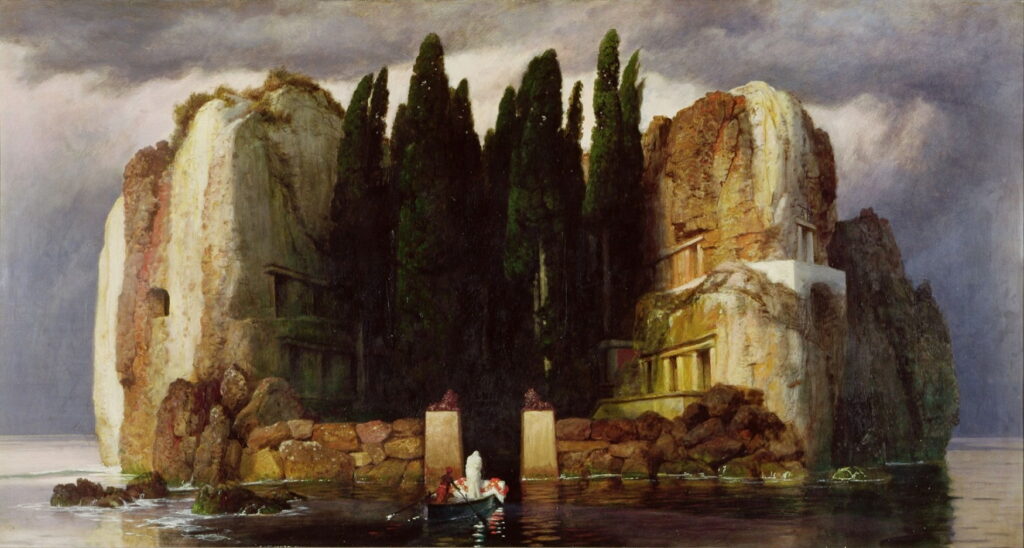Sea of Mists: Influenced, Arnold Böcklin 2

The Swiss artist Arnold Böcklin (1827–1901) had already demonstrated his influence by Caspar David Friedrich and other German Romantic painters by the early 1870s, when he was working in Munich again. He then spent almost a decade settled in Florence, until 1885.
Arnold Böcklin (1827–1901), Spring in a Narrow Gorge (1881), oil on canvas, 84.5 x 59.4 cm, J. Paul Getty Museum, Los Angeles, CA. Wikimedia Commons.
Spring in a Narrow Gorge (1881) seems to be a straightforward landscape painting, of a few birch trees in fresh Spring foliage (although the reference in the title isn’t to the season), in a narrow gorge. The water source of the title quite probably runs among the rocks at the base of the gorge, but isn’t readily visible.
Arnold Böcklin (1827–1901), Summer Day (1881), oil on mahogany wood, 61 x 50 cm, Staatliche Kunstsammlungen Dresden, Dresden, Germany. Wikimedia Commons.
Böcklin’s Summer Day (1881) shows a small river meandering through meadows, with summer flowers out on the grass, and white blossom on the strange-looking trees. In the background is a town, and half a dozen children are playing in or near the water, in the foreground. It has an air of calm and timelessness, otherwise it doesn’t seem to invite any deeper reading.
Arnold Böcklin (1827–1901), Ruin by the Sea (1881), oil on fabric, 111 x 82 cm, Cleveland Museum of Art, Cleveland, OH. Wikimedia Commons.
Ruin by the Sea (1881) makes its intent clear in returning to a more Romantic theme. The ruins of an old building are just above the waves. Growing within the broken walls are three cypress trees which lean away from the prevailing wind. Above them the sun’s rays break through banks of cloud in a dramatic light, and a large flock of crows are arriving to perch on the top of the walls. The ruin represents decay, perhaps that of later life, and the crows are harbingers of death. Cypress trees also have a strong association with cemeteries.
Arnold Böcklin (1827–1901), Sacred Grove (1882), oil on canvas, 105 x 150.6 cm, Kunstmuseum Basel, Basel, Switzerland. Wikimedia Commons.
Many artists associated with German Romantic and Symbolist movements painted groups of worshippers within ancient trees, often under similar titles to Böcklin’s Sacred Grove, from 1882. The nine figures here are shrouded in white habits indicating their religious association. On top of a stone altar is a bright flame, at which three of them are bent low and kneeling in obeisance. Behind the grove, in the distance, is what appears to be a large stone building like a temple or monastery. In the foreground is a large pond in which white flowers are starting to open. However, the foliage of the trees indicates that it is autumn/fall.
Between 1880 and 1886, Böcklin painted a total of five different versions of his most famous work, Island (or Isle) of the Dead. Each shows a similar island, probably based in part on the English Cemetery in Florence, where his own baby daughter had been buried. Each shows the deceased being rowed across to the island, which calls on the classical myth of Charon, who rows the dead over the rivers Styx or Acheron to the underworld.
Arnold Böcklin (1827–1901), Island of the Dead (version 1) (1880), oil on canvas, 110.9 x 156.4 cm, Kunstmuseum Basel, Switzerland. Wikimedia Commons.
Böcklin painted the first version in 1880 for his patron Alexander Günther. This shows the boat just outside the harbour of a small rocky island which appears to be lined with mausoleums. The light is remarkable, seemingly a bright twilight, against dark water and sky. However the direction of travel of the boat is ambiguous, as it may actually be moving away from the island and towards the viewer.
While he was working on that version, the widow of a financier, Marie Berna, visited his studio in Florence, and commissioned a smaller version in memory of her first husband, who had died of diphtheria in 1865. For this, the artist added the standing figure and coffin, which he also added to the first version. At that time, Böcklin had titled the painting Tomb Island.
Arnold Böcklin (1827–1901), Island of the Dead (version 3) (1883), oil on panel, 80 x 150 cm, Alte Nationalgalerie, Berlin. Wikimedia Commons.
The third version of Island of the Dead was painted in 1883 for Böcklin’s dealer. The first two versions had encountered criticism. He accordingly changed the lighting and closed in on his motif, making this version much clearer that the boat was entering the island’s tiny harbour. Although less dramatically lit, this adds clarity to the most important part of the painting, as shown in the detail below.
Arnold Böcklin (1827–1901), Island of the Dead (version 3) (detail) (1883), oil on panel, 80 x 150 cm, Alte Nationalgalerie, Berlin, Germany. Wikimedia Commons.
He painted a fourth version in 1884, which was sadly destroyed during the Second World War.
Arnold Böcklin (1827–1901), Island of the Dead (version 5) (1886), oil on panel, 80.7 x 150 cm, Museum der bildenden Künste, Leipzig, Germany. Wikimedia Commons.
The fifth version was commissioned by the Museum of Fine Arts in Leipzig, and was painted in 1886.
In 1888, Böcklin painted a complement, with the title Island of Life, and in the year of his death, a sixth version was in progress, which was completed by his son Carlo.
A great deal has been written and speculated about this remarkable series of paintings. Böcklin evokes mood, of a poignant calm, of death and loss. During the 1880s, its reputation grew. It was reproduced as a print by Max Klinger that sold strongly. Reproductions were bought by the Swedish artist Prince Eugen, and Georges Clemenceau, Prime Minister of France. By the early twentieth century, several artists had painted their own interpretations of the image. It has influenced countless painters, poets, writers, and other artists since.
Arnold Böcklin (1827–1901), Attack by Pirates (1886), oil on mahogany panel, 153 x 232 cm Wallraf-Richartz-Museum, Cologne, Germany. Wikimedia Commons.
Böcklin’s Attack by Pirates (1886) is perhaps a more direct German Romantic work, showing a group of pirates attacking some Italianate buildings atop the sheer cliffs of a tiny island connected by a viaduct. The attackers have already set light to the buildings, casting an eerie red light against the black clouds. Perhaps the artist felt that he was coming under similar attack by his critics.
That year, Böcklin moved from Florence to Zürich in Switzerland, where he turned more to narrative and mythological works. Then in 1892, he moved for the last time, to San Domenico near Florence, where he remained until he died in early 1901.
Arnold Böcklin (1827–1901), The Chapel (1898), oil on canvas, 95 x 70 cm, Private collection. Wikimedia Commons.
The Chapel, from 1898, is one of Böcklin’s last Romantic landscapes, and returns to similar sea-swept ruins as those in Ruin by the Sea above, but with some important changes. Here there is no doubt that the waves are destroying the remains of this chapel, as they crash against its walls. The cypresses are still curved with the wind, but instead of black crows there are white doves of peace. On the remains of the steps at the right are red flowers, which could have several associations, including love.




